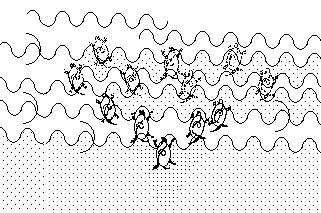Through almost nine years in the history of this corner, there wasn't any haiku
from South America, I realized. It was because of my inability to read their languages.
But I wanted to feel what and how they see in this season.
So I contacted the editor of a Brazilian Haiku Magazine, "CAQUI," Mr. Edson Kenji Iura.
Then he kindly introduced me to Ms. Rosa Clement; and she sent me this bilingual haiku.
At the same time of our season of falling leaves with cold wind, many new baby turtles are
vigorously swallowed into the humming Amazon. Imagining the view of this haiku,
a miraculous and happy feeling of living in this planet comes up to me.
The author, Ms. Clement, also wrote an article about Brazilian haiku history:
"Haiku in the Country of Samba." According to it, in contrast to Samba simply becoming
the national rhythm of the country, haiku societies in Brazil are continuously discussing
between groups over haiku rules since a Frenchman introduced haiku
in the early 20 century. Because of the differences of language systems and cultures
between original Japanese and Portuguese, just as other countries even including Japan
have to decide between following the tradition or going to new ways.
Thinking of the other side of the earth and culture can help to see a new global haiku, I feel.
Phenomena of a season are not common in the world, but still a seasonal word can
make haiku alive as well as global common subjects and humors, I think.
もうすぐ9年に近いこのコーナーで、ことばが読めないとはいえ南米のハイクを
一度も取り上げなかったことに気付きました。日系人もいるブラジルは
どんな状況なんだろう?逆の季節観にも触れてみたいと、サーチしました。
ブラジルのハイク雑誌(ポルトガル語) "CAQUI"(柿) の編集者で
日系三世のEdson Kenji Iuraさんのご親切な仲介で、Rosa Clementさんに
この季節のポルトガル語と英語のハイクを送っていただくことができました。
木枯らしが木々を裸にしてゆく同じ時間に、たくさんの元気な赤ちゃん亀が
アマゾンに泳ぎだしている・・このハイクのそんな光景を想うと、
地球に生きている不思議さと喜びがふつふつと涌いてきます。
Rosaさんはまた、ブラジルのハイクの流れについても 「サンバの国のハイク」で
紹介しておられます。サンバが国民のリズムとしてどこに行っても一定に定着した
のに比べ、20世紀初頭にフランスからもたらされて以来、ハイクは、
575のシラブル・押韻を踏む・季語・暗喩や直喩・自然や神の擬人・ユーモアなどを
ポルトガル語の文化としてどう扱うかで行きつ戻りつ揺れながら
ゆっくりとひろがっているそうです。
地球の反対側に心を寄せるところからグローバルなハイクのあり方が
開けてきそうな気がします。また、季節の現象はまったく共通ではありませんが、
それでもなおローカルな季節感は俳句を生かしつづけるでしょう。
 Original
Portuguese Haiku by Rosa Clement:
Original
Portuguese Haiku by Rosa Clement:






 : turtle (亀),
: turtle (亀),
 : wave (波),
: wave (波),
 {
{ particles,
particles,  rock{
rock{ nature,
nature,  infinite,
infinite,  hard} }: sand (砂)
hard} }: sand (砂) wave,
wave, end): beach (浜)
end): beach (浜) : the grammatical
symbol for nominative (only when the subject is not at the head of a sentence)
: the grammatical
symbol for nominative (only when the subject is not at the head of a sentence) {
{ reptile {
reptile { rolled,
rolled,  (for the ellipse body shape)}: turtle/tortoise (亀)
(for the ellipse body shape)}: turtle/tortoise (亀) : verb mark (動詞符)
: verb mark (動詞符) : minus/leaving (マイナス/引き去る)
: minus/leaving (マイナス/引き去る) the heading direction}: to, for (~へ/に向けて)
the heading direction}: to, for (~へ/に向けて)
 : waves (visually show it's plural or repeating) (くり返す波)
: waves (visually show it's plural or repeating) (くり返す波) time/ear shape,
time/ear shape,  wave} (a sort of wave recognized by 'ear' and with 'time'): sound (音)
wave} (a sort of wave recognized by 'ear' and with 'time'): sound (音)